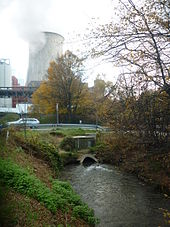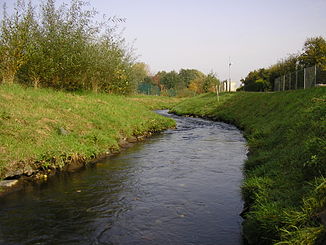Gillbach
| Gillbach | ||
|
Gillbach near Rommerskirchen |
||
| Data | ||
| Water code | EN : 2748 | |
| location | North Rhine-Westphalia , Germany | |
| River system | Rhine | |
| Drain over | Erft → Rhine → North Sea | |
| source |
Bergheim - Auenheim ( Niederaussem power station ) 50 ° 59 ′ 52 ″ N , 6 ° 39 ′ 42 ″ E |
|
| Source height | 93 m above sea level NN | |
| muzzle |
Erft in Neuss - Weckhoven Coordinates: 51 ° 9 ′ 37 ″ N , 6 ° 41 ′ 20 ″ E 51 ° 9 ′ 37 ″ N , 6 ° 41 ′ 20 ″ E |
|
| Mouth height | 38 m above sea level NN | |
| Height difference | 55 m | |
| Bottom slope | 1.9 ‰ | |
| length | 28.5 km | |
| Catchment area | 98.674 km² | |
| Big cities | Neuss | |
The Gillbach (also: the Gillbach) is a right tributary of the Erft . The water flows in North Rhine-Westphalia .
River course

The "source" of the Gillbach is located in Auenheim near Bergheim on the northern foothills of the Villerück at 93 m above sea level. NN . There it is fed by the cooling water from the Niederaussem power plant . Its original headwaters, the Bethlehem Forest, was excavated by the Bergheim and Fortuna-Garsdorf opencast mines between the 1950s and 1980s.
The Gillbach flows through the urban area of Bergheim in the Rhein-Erft district , the municipality of Rommerskirchen , the city of Grevenbroich and the city of Neuss in the Rhine district of Neuss .
Other tributaries of the Gillbach are mainly ditches that divert rainwater from the fields. These so-called rivers usually dry out in summer. The Bohnenbach was a constantly flowing tributary; it flowed through Oberaußem and Niederaußem and flowed into the Gillbach near Auenheim. The Bohnenbach was the main source tributary of the Gillbach. It initially led rainwater from the foothills of the Villerück and later sewage to the Gillbach. Due to the odor nuisance, the water was canalized and led underground. The treated wastewater from Oberaussem is discharged into the Gillbach today.
history
The areas by the brook have been inhabited by people since the younger Stone Age. The first testimonies left by humans date from around 400 BC. Finds near Auenheim prove this.
The Gillbach was the namesake of the Gillgau , a medieval Franconian county .
Due to the fertile soil to the right and left of the watercourse, the landscape from Niederaussem to shortly before Neuss was also referred to as "The Gilbach". In several newspaper supplements from the 1950s, which appeared under the title "Between Erft and Gillbach", local journalists went into detail on the eventful history of the Bergheim (Erft) district at that time .
Sights on the Gillbach
- Niederaussem power plant
- Coal refining company Fortuna-Nord
- St. Medardus ( Auenheim )
- Ordenshof (Auenheim)
- Mönchshöfe (near Niederaussem )
- Geretzhoven Castle (near Hüchelhoven )
- St. Michael ( Rheidt-Hüchelhoven )
- St. Peter (Rommerskirchen)
- Anstel Castle
- Lambertus Chapel (approx. 9th century) in Rommerskirchen-Ramrath , one of the oldest chapels in the Rhineland.
Infrastructure at the Gillbach
There are many hiking and cycling trails along the Gillbach.
The railway line from Cologne to Mönchengladbach crosses the Gillbach in the municipality of Rommerskirchen directly in front of the Steinbrückerhof. The two lines RE 8 (Rhein-Erft-Express) and RB 27 (Rhein-Erft-Bahn) operate on this railway line. The former railway line Rommerskirchen - Niederaussem - Bergheim / Quadrath-Ichendorf (part of the "Strategic Railway Embankment" ) runs about 500 meters between Rommerskirchen and Niederaussem . Since the 1970s, only goods traffic of today's RWE Power AG has taken place here.
The B 477 and the B 59 run along the Gillbach .
Alien species in the Gillbach
Due to the increased temperatures in the Gillbach, some introduced animal and plant species (scientifically: Neobiota ) have settled there over the past decades , which were probably released there primarily by hobby aquarists . The proven species include guppies , zebra cichlids , freshwater shrimp of the genus Neocaridina and tropical aquatic plants such as Vallisneria . Recently a population of was in June 2017 Marie cichlids and hybrids of Oreochromis mossambicus and Oreochromis niloticus described. Scientists from the University of Frankfurt also reported in September 2015 that introduced parasites of the species Camallanus cotti can infect the non-native zebra cichlids as well as domestic chub and gudgeon .
Individual evidence
- ↑ a b German basic map 1: 5,000
- ↑ a b Topographical Information Management, Cologne District Government, Department GEObasis NRW
- ↑ Jourdan et al. (2014): On the natural history of an introduced population of guppies (Poecilia reticulata Peters, 1859) in Germany. . BioInvasion Records. Retrieved August 22, 2017.
- ↑ Emde et al. (2016): Cooling water of power plant creates “hot spots” for tropical fishes and parasites . Parasitology Research. Retrieved August 22, 2017.
- ↑ Lukas et al. (2017): On the occurrence of three non-native cichlid species including the first record of a feral population of Pelmatolapia (Tilapia) mariae (Boulenger, 1899) in Europe . Royal Society Open Science. Retrieved August 22, 2017.
- ↑ Klotz et al. (2013): Two Asian fresh water shrimp species found in a thermally polluted stream system in North Rhine-Westphalia, Germany. . Aquatic Invasions. Retrieved August 22, 2017.
- ↑ Lukas et al. (2017): On the occurrence of three non-native cichlid species including the first record of a feral population of Pelmatolapia (Tilapia) mariae (Boulenger, 1899) in Europe . Royal Society Open Science. Retrieved August 22, 2017.
- ↑ Emde et al. (2016): Cooling water of power plant creates “hot spots” for tropical fishes and parasites . Parasitology Research. Retrieved August 22, 2017.
